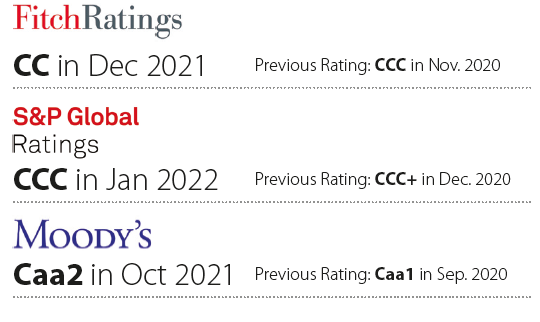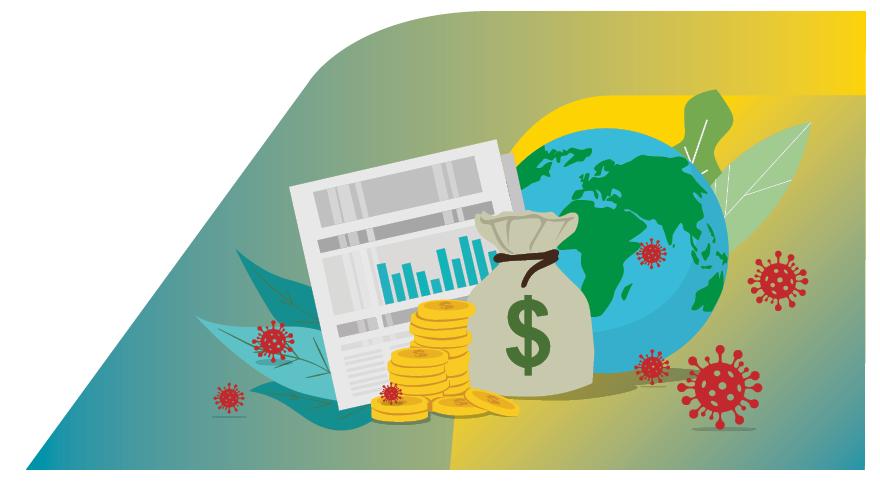This Annual Report is meant to be read in the backdrop of the global and local developments elaborated below that contextualise the Bank’s performance.
Global economy
The global economy experienced a rebound in growth in 2021 aided by accommodative fiscal and monetary policies. Global growth is expected to moderate in 2022 and inflation is expected to persist longer. Higher interest rates experienced globally will make borrowings more expensive, especially for countries borrowing in foreign currencies and at short maturities.
The global economy enters 2022 in a weaker position than previously expected. COVID-19 variants continue to evolve and countries are imposing restrictions. Russia just invaded Ukraine.
The Russian Invasion of Ukraine – global implications
The Russian invasion of Ukraine has sent the Brent Crude oil price above USD 100 per barrel mark (as at February 24, 2022). The price of gold too has recorded an increase with investors moving on to safe haven assets. The conflagration is also likely to disrupt supply chains. The EU accounts for 27% of Russian exports. China accounts for about half of that. Russia is a key supplier of natural gas and oil. Russia and Ukraine together account for a quarter of the world’s wheat supply. Further, Russia is one of the world’s key suppliers of industrial metals.
Rising energy prices and supply disruptions will result in higher and more broad-based inflation than anticipated, notably in the United States and many emerging market and developing economies. The ongoing concerns about China’s real estate sector and slower-than-expected recovery of private consumption also have limited growth prospects.
Sri Lankan economy
In Sri Lanka, the economy is estimated to have recorded a growth of around 4% in 2021. A marginal drop in the growth rate is expected in 2022. In 2021, a buildup in inflationary pressures could be observed stemming from both supply side and demand side. In line with these inflationary pressures, a gradual rise in interest rates could be observed and this is expected to continue in the period ahead. On the external front, exports recorded a commendable performance in 2021 and imports too increased significantly. In line with these developments, the trade deficit widened notably applying downward pressure on the Sri Lankan rupee.
The Russian Invasion of Ukraine – implications for Sri Lanka
Sri Lanka’s expenditure on oil imports was set to rise in 2022, but the Russian invasion of Ukraine will aggravate the situation. In 2022, Sri Lanka’s exports (mainly tea exports) to Russia will be adversely affected due to the economic sanctions imposed against Russia by the US and its allies. Tourist arrivals to Sri Lanka from Ukraine (an emerging source market) are likely to be adversely affected in 2022 due to the Russian invasion of Ukraine. Russia has been the top source market in terms of tourist arrivals in recent times. The tourist arrivals from Russia may also be adversely affected due to the war.
Bangladesh Economy
In Bangladesh, after almost a decade of robust growth, reaching a high of 8.15% in 2019, momentum was severely blunted by the COVID-19 pandemic during 2020, and growth slowed to 3.5%. In 2021, however, the economy rebounded to some extent and grew by 5.5%. The Government projects a 7.2% GDP growth for 2022, and a return to pre-pandemic levels by 2023.
The monetary policy stance and monetary and credit programs outlined for 2021 were mostly successful in terms of injecting sufficient liquidity into the system, accompanied by a softer market interest rate regime aimed at containing inflation while ensuring stability in both the local and the foreign currency markets. The CPI-based average inflation remained at mid-single digit level in 2021 hovering around the target of 5.80% and is expected to remain above 6.00% during the year 2022. Credit to the private sector saw an uptick in 2021. Both the DSE and the CSE bourses remained buoyant during 2021.
The Russian Invasion of Ukraine – implications for Bangladesh
The most immediate impact on the Bangladesh economy is likely to be a surge in energy prices. This will increase the prices of fertilizer which can cause a crisis situation requiring Government intervention. Wheat imports from Russia and Ukraine too may be affected. Rising imports payments, fall in export receipts, pressure on exchange rate, rising commodity prices leading to inflation can be expected. In the long term, ongoing Russian projects in Bangladesh in the power and gas sectors may be affected with the sanctions on Russia over banking transactions and disruption of key material supplies.
Global Economy
Indicator |
2021 |
2022 OUTLOOK |
| Growth | Rebounding growth at 5.9% est. (IMF)
(Source: IMF) |
Growth to moderate to 4.4%The Russian invasion of Ukraine will have a serious economic impact, which will worsen the longer it continues. This crisis comes at a delicate time, when the global economy is recovering from the ravages of the COVID-19 pandemic and threatens to undo some of that progress. The immediate global implications of the war will be higher inflation, lower growth, and some disruption to financial markets as deeper sanctions take hold. (Source: IMF) |
| Fiscal and Monetary Policy | Accommodative fiscal and monetary policies |
Gradual withdrawal of accommodative fiscal and monetary policies.A less accommodative monetary policy in the United States is expected to prompt tighter global financial conditions, putting pressure on emerging market and developing economy currencies. Higher interest rates will also make borrowing more expensive worldwide, straining public finances. For countries with high foreign currency debt, the combination of tighter financial conditions, exchange rate depreciations, and higher imported inflation will lead to challenging monetary and fiscal policy trade-offs. |
| Interest Rates | Low interest rates |
Gradual rise of interest rates |
| Inflation | Rising energy prices and supply disruptions have resulted in higher and more broad-based inflation |
Higher inflation expected as a result of the Russian invasion of Ukraine |
| Energy and Commodity Prices |
Rise in global energy and commodity prices |
Surge in energy and commodity prices expected as a result of the Russian invasion of Ukraine.
|
| Supply Chains | Rise in supply chain disruptions |
Supply chain disruptions to worsen due to the |
| Trade | Global trade is estimated to have reached about |
The outlook for 2022 remains very uncertain (UNCTAD). |
| Equity Market | A strong year for global equities |
Outlook looks bright for global equities (Bloomberg). |
| COVID-19 | By the end of the year, more than 5.4 million people died of COVID-19About 48% of the population globally |
Faster vaccine production and distribution of vaccines seem to protect against severe illness. However, the emergence of new COVID-19 variants could prolong the pandemic and induce renewed economic disruptions. |
| Geopolitical | Geopolitical risks remain elevated |
Geopolitical risks remain elevated |
| Cyber attacks | An increase in the spread and destructiveness of |
The spread and destructiveness of cyber attacks will further increase. |
| Climate issues | More adverse climate shocks |
The frequency and magnitude of climate shocks are expected to increase. |
Sri Lankan Economy
Indicator |
2021 |
2022 OUTLOOK |
| Growth | Rebounding growth at 4.0% est. (CBSL)
(Source: Department of Census and Statistics) |
Marginal decline in growth is expected |
| Fiscal & Monetary Policy | Accommodative fiscal and |
Gradual withdrawal of accommodative fiscal and monetary policies |
| Interest Rates | Low interest rates
(Source: Central Bank of Sri Lanka) |
Gradual rise of interest rates |
| Inflation | Rising inflation
(Source: Department of Census and Statistics) |
Inflationary pressures to remain |
| Energy and Commodity Prices |
Rise in energy and commodity prices |
Surge in energy and commodity prices expected as a result of the Russian invasion of Ukraine and economic sanctions against Russia. |
| Supply Chains | Rise in supply chain disruptions |
Supply chain disruptions to worsen due to the Russian invasion of Ukraine and economic sanctions against Russia. |
| Trade | A notable improvement in export performance was observed while expenditure on imports increased significantly. |
Trade outlook remains uncertain.Sri Lanka’s exports (mainly tea) to Russia will be adversely affected due to the economic sanctions imposed against Russia by the US and its allies. Russia is one of the biggest destinations of Ceylon tea. |
| Equity Market | Strong performance recorded mainly driven by low interest rates and local investors |
Stock market performance likely to be checked due to an anticipated rise in interest rates |
| COVID-19 | By end of year, nearly 15,000 deaths were caused by COVID-19About 64% of the population has been fully vaccinated |
With greater numbers being vaccinated, domestic lockdowns are not expected to take place. Therefore, domestic economic activity is likely to continue without disruptions. |
Issues faced specifically by Sri Lanka
Rating downgrades over concerns about sovereign debt sustainability amidst deteriorating fiscal position

Debt Issue: Deteriorating external financial position.
Exchange Rate: The Sri Lanka rupee depreciated by 6.5% against the US dollar in 2021. It is expected to significantly depreciate
if the Government decides to float the rupee. However, this process may be sequenced so that there will not be a sudden shock impact.
if the Government decides to float the rupee. However, this process may be sequenced so that there will not be a sudden shock impact.
(Source: Central Bank of Sri Lanka)
Foreign Currency shortage created pressure on exchange rate to depreciate and shortage in certain goods.
Remittances and Tourism Income which are two of the main foreign income earners were badly affected due to the pandemic.
Russia was the second largest source market in terms of tourism arrivals to Sri Lanka during 2021 with a total count of 16,894. Meanwhile with 7,037 tourists, Ukraine became the fifth largest source market for 2021. Ukraine closing its air space and international sanctions on Russian air space will certainly have an adverse impact on Sri Lanka's tourism industry.
Power crisis may lead to a disruption in export activity – this in turn can aggravate the dollar crisis.
The change from chemical to organic fertilizer has created a shortage in rice and vegetables thus contributing to very high food inflation.
Financial Industry
With comfortable levels of capital and liquidity, the Banking Sector continued to remain resilient amidst the COVID-19 pandemic. However, the financial services sector had to contend with the following issues:
- Prolonged moratoria granted to the pandemic-affected sectors
- Shortfall in foreign currency liquidity
- Proposed one off Surcharge Tax and increase in other taxes likely to impact profit retention and capital adequacy
- Increasing stock of credit to Government and State-owned business enterprises by licensed banks
- Emerging threats to operational resilience including IT and cyber security
- Traditional financing challenged by the emerging Fintechs
- Implementation of the consolidation programme of the non-banking sector has been slow
The Bank
| CBC performance compared to the Banking Sector – End Sep 2021 | ||
Banking Sector * |
CBC |
|
Assets and Liabilities (Rs. Bn.) |
||
Gross Loans and Advances |
10,355 |
1,051 |
Deposits |
12,466 |
1,420 |
Assets |
16,494 |
1,930 |
Profitability (%) |
||
Return on Assets (ROA) Before Tax |
1.7 |
1.8 |
Return on Equity (ROE) |
15.1 |
15.5 |
Assets Quality (%) |
||
Gross Non-performing Advances Ratio |
4.8 |
4.9 |
Capital Adequacy (%) |
||
Core Capital (Tier 1 Capital) Adequacy Ratio |
12.9 |
12.2 |
Total Capital Adequacy Ratio |
16.2 |
16.1 |
Liquidity (%) |
||
Current & Savings Deposits to Total Deposits |
36.3 |
47.1 |
*Banking Sector = Licensed Commercial Banks + Licensed Specialized Banks
Source: CBSL, CBC Interim Financial Statements

